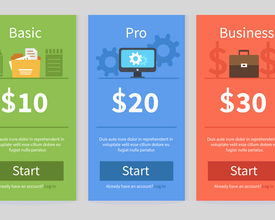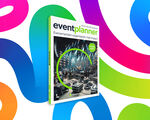Evaluating and deciding the attendance fees isn’t enough. To attract more attendees and make them understand the undeniable worth of your event, you must set up a smart pricing proposal.
Instead of just throwing out a few numbers, it’s important to design attractive pricing packages for your potential attendees. During this process, you should consider different psychological layers that will convince people to register for and pay to attend the event. Obviously, you could just list different fees (depending on the attendee type) on your website and be done with it. But you won’t be doing yourself any favors.
Not being 100% clear and specific about the fees plus providing a flat design to your event pricing may cause people to walk away.
How do pricing plans work? First, pricing packages give your attendees the feeling of choice. Second, well-designed and structured plans are easy to understand. Finally, by setting up smart pricing plans, you’re able to embed customized value that’s fully aligned with your attendees’ profile. The purpose of creating plan-based pricing is to actually nudge potential attendees toward the desired actions (register and buy the event ticket), this way increasing your profits.
Considering this, here’s what you should take into account if you want to build attractive pricing plans for your next event:
Tip 1. Carefully define your event’s value proposition
Let’s start by saying that pricing plans aren’t an option for all events. This depends on the value you can offer and the types of attendees you have. You may run events that provide an equal value for all the attendees, in which case designing a pricing plan may be unnecessary. To understand whether you need a simple ticketing model or different plans, you must define your event’s value proposition.
Trade shows and exhibitions are good examples.
Let’s consider the entire variety of value these events provide: access to booths and B2B meetings, spend meetings, potential knowledge sessions, etc. In this case, you can easily set up different pricing plans and offers people various packages to choose from.
Tip 2. Consider the differences between the prices
Unclear value proposition can put off even the most interested potential attendee. If you choose to design a few pricing plans, be very transparent in the differences between them and what your guests will get by choosing one over another.
For example, let’s say you have three pricing plans: basic, professional, and premium. To remove any information clutter, ambiguity, or confusion, you’ll need to indicate exactly what each plan offers. In other words, under each plan package, along with mentioning any additional fees attendees will have to pay, you should also list what features that plan includes.
Tip 3. Offer a comparison chart
One way of efficiently presenting each plan’s features is to provide information through comparison. In other words, if we take the example of trade shows and exhibitions, you could create a comparison chart between the privileges a basic visitor has compared to a professional or premium visitor.
For example, a basic visitor may not have access to the knowledge sessions or speed meeting area, whereas a professional visitor may have access to everything except the option to participate in a B2B matchmaking dynamic with the exhibitors. Meanwhile, a premium visitor may have access to all activities without any restrictions. By using a comparison chart to highlight the features for each pricing plan, you’ll make things more transparent and help people better visualize what each plan offers.
Tip 4. Apply the rules of anchoring effect
As a Kissmetrics article indicates, “Even though more accurate information may be presented later, people tend to rely on the first piece of information they receive.” If your intention is for people to purchase the medium pricing plan for your event, you’ll have to somehow highlight this package from the rest. This doesn’t have to be overcomplicated; you can do it by simply indicating a different color. The main idea here is to make the pricing plan stand out among the rest.
Tip 5. Avoid providing too many options
Three to four pricing plans for attending the event is enough. Don’t offer tons of packages that nobody will have the time to read through and evaluate. People tend to feel incapable of choosing when faced with too many options. Keep it simple so your potential attendees can clearly understand the differences between the various pricing plans.
Call to action
Start by understanding if you even need pricing plans in the first place. Not all events need to use this strategy. Focus on how many pricing plans you want (don’t go overboard) and the target group for each package. Make sure to display each plan’s features in detail to avoid any confusion. Finally, if you want to nudge attendees to purchase one package over another, employ the anchoring effect and make that desired pricing plan really stand out from the rest.








